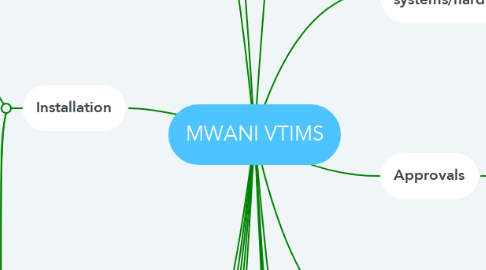
1. Project Team
1.1. Project Manager
1.2. Contract Management
1.3. Project Engineer
1.3.1. Installation teams, on-site
1.4. PRO
1.5. Finance
1.6. Project Coordinators
1.7. Project planning/scheduling
1.8. Document Control
1.9. Quality and HSE
1.10. Accounting
1.11. Logistics
1.12. Experts
2. Mandatory Personnel
2.1. Contractor
2.1.1. Project Mager
2.1.2. System Engineer
2.2. VTMS manufacturer
2.2.1. Project Mager
2.2.2. System Engineer
3. Installation
3.1. Scope of works
3.1.1. Lifting equipment e.g. crane for radar
3.1.2. Works on heights
3.1.3. Indoor works
3.1.4. Calibration
3.1.4.1. Meteo stations
3.1.4.2. Boat for calibration
3.1.4.2.1. CCTV
3.1.4.2.2. Radar
3.1.4.2.3. VHF
3.1.5. Configuration
3.1.5.1. Hardware
3.1.5.1.1. Radar
3.1.5.1.2. CCTV
3.1.5.1.3. AIS Base Station
3.1.5.1.4. VHF
3.1.5.2. Software
3.1.5.2.1. VTS
3.1.5.2.2. MIS (VTS DB)
3.1.5.2.3. Migration of data from existing system
3.1.5.3. Data Network
3.1.5.3.1. Data links between sites and HQ
3.1.5.3.2. Routers, firewalls, LAN Switches
3.1.5.3.3. External interface
3.1.6. Disposal of obsolete equipment
3.2. Metal structures for equipment fixing
3.3. Cables, surge protectors, connectors, jumpers
4. Acceptance
4.1. FAT
4.1.1. System FAT
4.1.2. Equipment FATs
4.1.2.1. Radar
4.1.2.2. CCTV
4.2. SAT
4.2.1. On sites
4.2.2. HQ and whole system
4.3. Handover
4.4. Punch list
5. Logistics
5.1. To KSA
5.2. Inside KSA
5.3. Customs clearance
5.4. Insurance
5.5. Storage
5.5.1. Central
5.5.2. On sites
6. System Design and Documentation
6.1. Master-Plan
6.2. Tests procedures
6.2.1. FAT (equipment)
6.2.1.1. Radar
6.2.1.2. CCTV
6.2.2. System FAT
6.2.3. SAT on-sites
6.2.4. SAT, HQ and final
6.2.5. SAT after punch-list rectification
6.3. BoM
6.4. Functional Block Diagrams
6.5. Wiring Diagrams
6.6. Cable Schedules
6.7. Site Plans
6.8. Civil and installation works specifications, method statements
6.9. Data flow diagrams
6.10. Telecommunication plan
6.11. Configuration
6.11.1. IP adresses
6.11.2. TDMA plans
6.11.3. Software configuration
6.12. Knowledge Base
7. SLA
7.1. Periodic Maintenance
7.2. Corrective Maintenance
7.3. Vendors
7.4. Local contractors
8. Training
8.1. Operators, Supervisors, Managers
8.2. System Administrators
8.3. Engineers
8.3.1. Customer
8.3.2. System Integrator
8.4. Vendor trainings
8.4.1. Factory
8.4.2. On-site
8.5. Learning Management System
9. Vendors
9.1. Radar
9.1.1. Terma
9.1.2. GEM Electronics
9.2. CCTV
9.2.1. Infinity
9.3. VHF
9.3.1. Spectra Engineering
9.4. Generatos
9.5. MW Links
9.6. Mast 30m
9.6.1. Zamil Steel
9.7. AIS Base Station
9.7.1. Kongsberg
9.8. IT equipment
9.8.1. Servers
9.8.1.1. On-stes
9.8.1.1.1. Single
9.8.1.2. HQ
9.8.1.2.1. Cluster
9.8.2. Workstations
9.8.2.1. PCs
9.8.2.2. Monitors
9.8.2.3. VTS Keyboards
9.8.2.4. VHF console
9.8.2.4.1. Touch-screen PC
9.8.2.4.2. PTT desk microphone
9.8.2.4.3. Speakers
9.8.2.4.4. PTT foot switch
9.8.3. LAN Switches, routers, firewalls
9.8.4. KVM console, PDU, Rack
9.8.5. UPS
9.8.6. Large screens
9.9. VTMS software
9.9.1. Wartsila
9.9.2. Leonardo
10. Integration wiht existing systems/hardware
10.1. AIS
10.1.1. CNS
10.2. VHF
10.2.1. Spectra Enineering
10.2.2. Omnitronics
10.3. Meteo Stations
10.3.1. Vaisala
10.4. Data buys
10.4.1. Axys
10.5. Radio Direction Finders
10.5.1. Rhotheda RT800
10.6. Jizan and Farasan system
10.6.1. Leonardo
10.7. Data network arrangement
10.7.1. STC
11. Approvals
11.1. Works
11.2. CST approval for radio transmitting equipment (radars, VHF)
12. Risks
12.1. Equipment damage
12.1.1. During delivery
12.1.1.1. to FAT
12.1.1.2. to KSA
12.1.2. During installation
12.2. Non acceptance
12.2.1. Additional equipment
12.2.2. Additional software, functionalities, integration
12.3. Lack of vendors support
13. Implementation
13.1. System Design
13.2. Manufacturing
13.3. Pre-assembly, testing, pre-configuration
13.4. FAT
13.5. Delivery to KSA, customs clearance
13.6. Installation, calibration, configuration
13.7. SAT
13.7.1. On-site
13.7.2. HQ and overall system
13.8. Trainings
13.8.1. On-site
13.8.2. HQ
